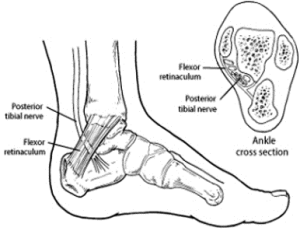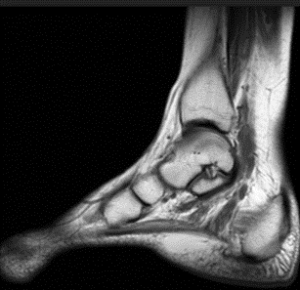Tarsal Tunnel Syndrome
Tarsal Tunnel Syndrome
The tarsal tunnel is the narrow space formed on the inside of the ankle (medial malleolus) and a thick ligament (flexor retinaculum) that protects and maintains the structures contained within the tunnel (arteries, veins, tendons and nerve). Tarsal tunnel syndrome is caused by a compression or squeezing on the posterior tibial nerve producing symptoms of from the ankle into the foot.
Patients with tarsal tunnel syndrome commonly report a tingling and burning sensation in the foot and ankle. Numbness and a ‘shooting pain’ into the foot is also often reported. Some additional symptoms associated with tarsal tunnel syndrome include;
- Pain often felt at the inside of the foot and ankle.
- Pain can be isolated or even radiate up into the calf.
- Symptoms may be exacerbated by standing for long periods of time.
- Symptoms may be exacerbated by excessive exercising (walking, running) or starting of a new exercise program.
Causes
Some common causes of tarsal tunnel syndrome include;
- Flat feet (over pronation) – people with flat feet are at risk for developing tarsal tunnel syndrome as the outward tilting of foot causing compression and irritation of the tibial nerve.
- Any swelling in the area causing compression of the nerve – ankle sprain, trauma.
- Space occupying lesions such as ganglions, bony spurs or cysts that can compress the nerve.
Treatment
A comprehensive podiatric assessment is recommended to prevent the progression of symptoms and ensure appropriate treatment is undertaken. Diagnostic imaging including a X-ray, Ultrasound and often a MRI may be required for further diagnosis.
A variety of treatment options, often used in combination are available to treat tarsal tunnel syndrome. At Sydney Foot Clinic the treatment options offered include;
- Rest and Ice – keeping off the foot and reducing activity prevents further injury and encourages healing. Ice can reduce inflammation, swelling and symptoms.
- Non-steroidal anti-inflammatory medication – help reduce the pain and inflammation
- Supportive footwear
- Custom made orthotic therapy – orthotics may be prescribed to address any biomechanical factors such as over pronation (flat feet) reducing pressure on the tibial nerve.
- Immobilization – restricting movement in a brace or cast is sometime necessary to reduce symptoms and reduce pressure on the tibial nerve
- Injection therapy – Injections of a local anaesthetic provide pain relief, and an injected corticosteroid may be useful in treating the inflammation.
Proper evaluation and diagnosis is important as the symptoms of tarsal tunnel syndrome can get confused with other conditions. It is important to seek early treatment for of tarsal tunnel syndrome as the symptoms can cause permeant nerve damage if left untreated. Surgical treatment of tarsal tunnel syndrome is sometimes required when there is no response to conservative management.


